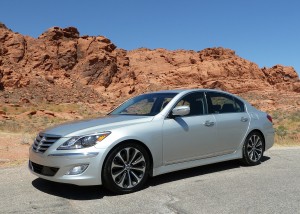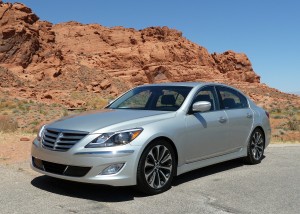Genesis adds potent new V8 in R Spec
By John Gilbert
Late in 2008, Hyundai took the automobile industry by surprise with the introduction of the Genesis, which was the South Korean company’s first attempt at anything other than an economy car.
The Genesis, an “entry luxury†sedan with strong performance, was a rousing success. It  won the 2009 North American Car of the Year award in its debut, and its high-tech, dual-overhead-camshaft 4.6-liter V8 was named one of the 10 best engines in the world by Ward’s.
In the ensuing two years, Hyundai has scaled some major peaks, with its record-setting midsize Sonata — which was the largest-selling car in the U.S. for the month of May — and for everything from its crossover SUVs to its compact Elantra and subcompact Accent, to say nothing of its all-out luxury Equus.
Genesis has spent 24 consecutive months setting records for year-over-year monthly sales increases. So it hardly seems there is any need for a revision. But for 2012, Hyundai has decided to show off its elevated standard for technology with a renewed Genesis, aiming squarely at the top BMW 5-Series, Mercedes E-Class, Infiniti M, and Lexus GS models. Exterior changes are subtle, minimal even. But under the hood, where the first Genesis offered a base 3.8-liter V6 or the award-winning 4.6-liter V8, there now are a trio of engines that should satisfy every type of buyer.
First, the base 3.8 V6 has been upgraded to a direct-injection version that is significantly improved, plus the 4.6 has been updated as well, although it has not been fitted with direct injection..
The prize, however, is an entirely new and mind-blowing direct-injection 5.0-liter V8, with 429 horsepower and 376 foot-pounds of torque, and a Hyundai-built 8-speed automatic transmission. Designed to power the larger super-luxury Equus, it also comes in the Genesis R Spec, which adds firmed up suspension, more high-performing steering, and asymmetric exhaust tailpipes — features befitting a luxury-sports sedan that will rocket from 0-60 in 5 seconds.
Driving the R Spec at the car’s introduction in the mountains just outside Las Vegas was a kick, because the car is so responsive. The Tau engine family, which includes the 4.6, showed off its new big 5.9 brother, and it comes with a high-pressure fuel pump to dish out 2,175 pounds per square inch of pressure in Hyundai’s direct-injection system. The tuned intake has electronic timing control, and the roller timing chain and camshaft carrier improve endurance while reducing friction.
Hyundai vice president Mike O’Brien explained that Hyundai’s precise direct injection system is “the single biggest improvement possible for improving the fuel economy of a gas engine. It’s all about the detonation of fuel, and with direct injection we can keep the fuel cool and raise the compression ratio, which improves the volumetric efficiency. The biggest challenge is that it is costly, so we have to weigh the advantages vs. the cost. But the component costs are coming down.â€
Direct injection itself, in which the fuel is metered into each cylinder’s combustion chamber on an individual basis, and sprayed as a fine mist with regulated pressure and temperature to enhance complete combustion, is not a new technique. Diesel engines have used it for decades, because the high pressure fuel being injected ignites more thoroughly in the extreme high-temperature diesel environment. It has been too costly and inapplicable in many gas engine usages, but a few companies have put it to use in recent years, mainly for increased power. Hyundai’s engineers in Korea seem to have found the sweet spot for improving power and fuel economy with GDI.
Building its own transmission helps, too, as Hyundai did with its 6-speed, and now the 8-speed, which shifts with silky smoothness. The tighter steering and suspension are particularly impressive, because they are areas where Hyundai engineers have not shown the same sophistication as in their recent engine-building.
The suspension of the R Spec includes higher spring rates, Sachs ASD shocks with improved damping, and a hollow rear stabilizer bar for added stability without extra weight.
Naturally, the 429 horsepower and the 376 foot-pounds of torque are major players in the car’s performance, and particularly impressive for low-end acceleration is that the torque reading is over 300 as low as 1,500 RPMs — barely above idle.
But here’s a secret. As potent as the new V8 is, installing GDI — gas direct-injection — on the 3.8-liter V6 puts that engine into a new performance category. Its power is up to 333 horsepower and 285 foot-pounds of torque, and most normal drivers looking for a different entry-luxury sedan with more than adequate pop and good fuel economy might be best advised to consider the Genesis with the V6. Especially if they don’t feel the urge to blow away from their neighbors’ sedans on the way to the shopping center. And, of course, the “generic†model with the 4.6 non-direct-injection engine remains in the line.
With any model of the 2012 Genesis you get LED accents to the headlights, a neat touch that was started by BMW, which circled its headlights with LED halos, then Mercedes got into the act. Audi has taken the technique to amazing heights, and now nearly every luxury car seems to require some sort of LED trademark to its lighting scheme.
All models also have the usual Genesis luxury car features, adding lane-departure warning, and heated rear seats.
As usual, Hyundai will price the Genesis significantly below its competitors. The base Genesis with the 3.8 V6 starts at $34,200, while moving up to the 4.6 V8 starts at $44,500. Choosing the loaded 5.0 R Spec with its direct-injected power and all the suspension upgrades puts its starting price at $46,500.
Hyundai checked out some of the best bargains among competitors and announced that the V6 Genesis will be $12,000 less than an Infiniti G37, and $14,000 under a Mercedes E350. The R Spec will be more than $16,000 under a loaded Infiniti M56, or Mercedes E550.
The new Genesis undoubtedly comes too soon after the original was Car of the Year for 2009, but the 2012 model is definitely an improvement over its predecessor, just as the new 5.0 is a major step forward over the 4.6 in both power and fuel economy.
Comments
Tell me what you're thinking...
and oh, if you want a pic to show with your comment, go get a gravatar!




 John Gilbert is a lifetime Minnesotan and career journalist, specializing in cars and sports during and since spending 30 years at the Minneapolis Tribune, now the Star Tribune. More recently, he has continued translating the high-tech world of autos and sharing his passionate insights as a freelance writer/photographer/broadcaster. A member of the prestigious North American Car and Truck of the Year jury since 1993. John can be heard Monday-Friday from 9-11am on 610 KDAL(www.kdal610.com) on the "John Gilbert Show," and writes a column in the Duluth Reader.
John Gilbert is a lifetime Minnesotan and career journalist, specializing in cars and sports during and since spending 30 years at the Minneapolis Tribune, now the Star Tribune. More recently, he has continued translating the high-tech world of autos and sharing his passionate insights as a freelance writer/photographer/broadcaster. A member of the prestigious North American Car and Truck of the Year jury since 1993. John can be heard Monday-Friday from 9-11am on 610 KDAL(www.kdal610.com) on the "John Gilbert Show," and writes a column in the Duluth Reader.